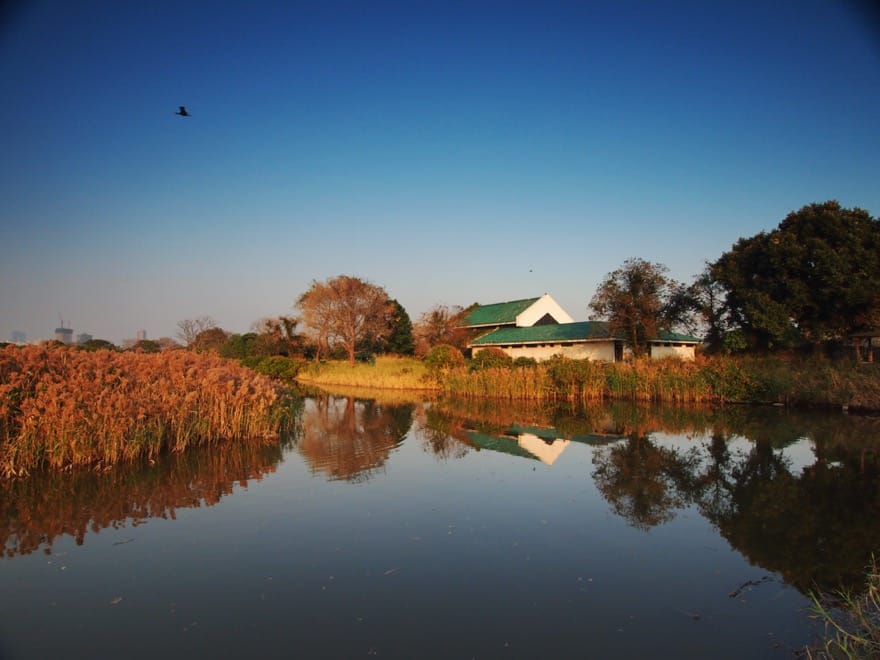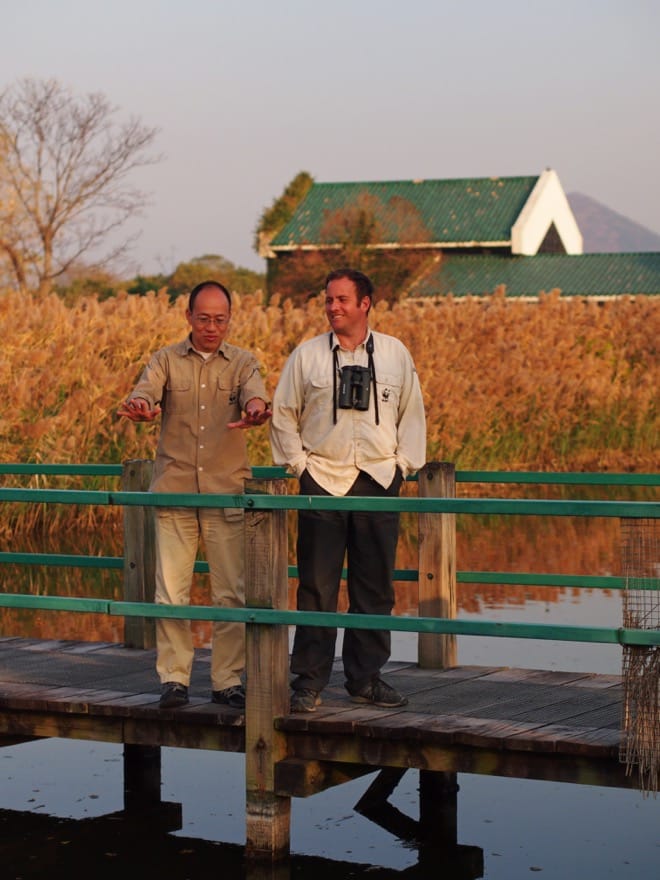With the apartment blocks of Yuen Long and Tin Shui Wai to the southwest, Fairview Park estate to the south, and the urban sprawl of Shenzhen fringing the north coast, Deep Bay may seem an unlikely location for one of the world’s greatest wetland reserves. Yet on the south shore lies the grandly titled Mai Po Marshes Wildlife Education Centre and Nature Reserve, often known simply as Mai Po Marshes, or even Mai Po.

The reserve’s area is 380 hectares: 20 times the size of Victoria Park. Most of the area is former shrimp ponds, and now jointly managed by the Agriculture, Fisheries and Conservation Department and WWF Hong Kong, though it’s the latter that does the hands-on work – and is the only member of WWF’s global network to manage a reserve.
Deep Bay is really a shallow estuary, which formed around 6000 years ago, as the ice age ended and the rising sea inundated a river valley. Silt carried in by streams and rivers built mudflats along the shorelines, and from the 13th century, man began reclaiming areas of land. The reclamation efforts accelerated last century, especially as farmers built bunds with sluice gates, to impound areas of mudflats. They grew salt-tolerant red rice on the new, marshy land.
At times, the farmers irrigated their paddies with water from the bay, and as the water came in so too did shrimp fry, which grew and were harvested and eaten by farmers. During the Japanese occupation in the early 1940s, this in turn gave rise to commercial shrimp farming, and at places including Mai Po new ponds were created specially to cultivate shrimps.
These ponds, called gei wai, were mainly shallow, and the farmers retained mangroves – trees adapted to life in tidal mud, perhaps as their leaves provided important nutrients. This in turn made the gei wai attractive to a host of waterbirds, such as herons, ducks and cormorants.
Early conservation measures, and Mai Po reserve established
The first conservation measures were in the 1970s, prompted by the planned construction of Fairview Park. With fears residents would walk through Mai Po, birdwatchers Mike Webster and Fred Hechtel successfully petitioned the government to protect the area, which was declared a site of special scientific interest.
“The land was effectifely kept on hold until WWF was formed, and was capable of running a managed reserve,” recalled David Melville, first manager of Mai Po Marshes and later executive-director of WWF Hong Kong, when I talked with him about the Mai Po’s history in 1990. “Shortly after being founded in 1981, WWF Hong Kong realised that if it was to be successful in raising funds for conservation, it had to explain to the people of Hong Kong what conservation was all about. So WWF looked for a suitable project, and the only one of any importance which was feasible was a managed reserve at Mai Po.”
Initial funds were obtained from the Royal Hong Kong Jockey Club, a consultant from the UK prepared a management plan, and in autumn 1983 WWF HK started to develop and manage the Mai Po Marshes Wildlife Education Centre and Nature Reserve. A visitor information centre and a concrete footpath were built, and after staff including Melville were recruited, the first guided visits for schools and the general public were organised in 1985. This was also the year that WWF Hong Kong started actively managing habitats, draining two adjacent gei wai so they could be interconnected.
By early 1987, when I arrived in Hong Kong, the reserve seemed well established. Facilities included an innovative floating boardwalk – a wooden walkway along a creek to the edge of the mangroves, where a viewing hide overlooked the mudflats at the heart of Deep Bay. Already, observations here were revealing far more about the bay’s wealth of birdlife than known from distant vantages.
Reeds had carpeted the two interlinked gei wai. But they were no match for the redoubtable Mary Hotung Ketterer, honorary director of WWF Hong Kong. She ordered the reeds burnt, to create an open expanse intended to attract shorebirds needing a place to roost when high tide covered the mudflats. This proved a huge success, with thousands of migratory shorebirds thronging the new lagoon in spring.
Hotung Ketterer also helped instigate the Big Bird Race. This was based on a British bird race, in which teams spent a day dashing about to find as many species as possible – but with an added twist: substantial fund-raising. From just two teams when first held in 1984, the race grew quickly, attracting more teams and sponsors, and becoming a key way WWF Hong Kong obtained funds to buy rights to manage more ponds, later providing crucial support for habitat management.
Star bird: Black-faced Spoonbill
The reserve was becoming known worldwide for birds including rare species, most of which passed through during spring and autumn migration, or arrived to spend the winter. But there was one species attracting relatively little attention, as it was regular in winter and thought to be common in China – Black-faced Spoonbill.

Standing around a metre tall, mostly white and with a long beak flattened at the tip, the spoonbill is easily seen and identified. Most local birdwatchers almost took seeing them for granted until one, Peter Kennerley, decided they might not be common after all and gathered data from around East Asia. He came up with a startling estimate for the entire world population: just 288 individuals. Virtually overnight, the spoonbill was recognised as critically endangered – the highest alert category for species facing extinction.
No one knew why the spoonbill was so rare, though the prime reason was probably destruction of coastal wetlands. And nor did anyone really know why numbers then increased, so that the spoonbill was removed from the critically endangered list in 2000. In recent years, the world population has been around two thousand, reaching a high of 2725 in last year’s census, and Deep Bay has consistently proved the second most important winter site for Black-faced Spoonbill.
Ramsar Site listing acknowledges international importance of Deep Bay
By 1990, WWF Hong was pressing the government to list Deep Bay under the Ramsar Convention of International Importance, which encourages management of wetlands for sustainable use. The bay met the criteria with ease, thanks to significant numbers of four endangered species – the spoonbill, Dalmatian Pelican, Saunders’ Gull and Nordmann’s Greenshank – and being one of the best remaining mangrove areas in south China. “If you look at satellite photos of the Pearl River delta, Deep Bay really shows up,” said Melville. “There is nothing else like it.”
In September 1995, the government indeed listed Mai Po Inner Deep Bay Ramsar Site of Hong Kong. Five zones were designated, permitting varying levels of activity, with Mai Po in the core zone.
Though this has not halted all threats to Deep Bay – where worrying changes included a sudden rise in silt levels during the 1990s, and plans for development at wetland areas are cause for concern – Ramsar status does seem to have put an end to ideas for extensive reclamations here.
Improving visitor programme
Mai Po centre manager Mathew Cheng began working for WWF Hong Kong in 2008, prompted by being impressed by his first visit to the reserve a decade earlier. “I thought WWF had done a very good job of managing Mai Po on behalf of Hong Kong people,” he says. He was tasked with enhancements such as improving facilities and the visitor programme.
“We had part time interpreters, who were not trained, and introduced new ideas, along with training through funding from HSBC,” says Cheng. “We also introduced an online booking system.”
Though visitor numbers have not substantially increased – there were 38,000 last year, compared with 25,000 in 1989 – the programme now generates more revenue. Plus, with tours for newcomers as well as people wanting a more in-depth excursion, there is an enhanced visitor experience, which Cheng believes is important given people might only visit Mai Po two or three times in their life.
“Hong Kong people care about this place,” says Cheng. “We did a survey two to years ago, including asking if you have been to Mai Po. Responses from people who hadn’t been here included, ‘It’s a very good place’. This was a surprise to me, that someone should know of a place but not come. Some said they came for the first time as a student, but never thought of returning.”
Cheng notes that there is a general feeling within WWF Hong Kong that there is a need to allow more visitors, but it’s important to sustain the experience. It might be possible to develop new routes, with new paths, allowing groups of around 25 people to tour without crowding.

The reserve also has a habitat management and monitoring manager, John Allcock. But is any habitat management really needed nowadays? “A lot of people think that if you have a reserve boundary and you protect what’s inside, it will be safe,” says Allcock. “Yet there is quite intensive management, so the reserve will continue to attract species we want. Without active management, it would be colonised by terrestrial vegetation.”
With gei wai gradually silting up, Allcock and his team periodically drain ponds so the mud be dug out, and they can be reflooded to provide open water needed by ducks and spoonbills. Plus, once or twice a month, they drain a pond to provide fish and shrimp banquets for egrets and spoonbills.
“We can also respond to changes, such as if a species is declining we can try management to attract it back,” says Allcock. One of these responses came when Black-winged Stilts – elegant, long-legged wading birds – first nested at Mai Po. Open islands were created, and protected from flooding. This worked for 10 years, with numbers peaking at around 50 pairs, though the stilts puzzled Allcock by failing to breed last year.
Allcock would also like to boost habitats for other wildlife. “For instance, there’s Mangrove Water Snake, which is restricted to mangrove habitats in south China, and there are a couple of moths that are probably unique to Deep Bay,” he says, though as yet little is known about any of these.
Just as Cheng says funding is a perennial problem, Allcock notes that lack of money restricts management work. Several possible large-scale projects are on hold, categorised as interesting to do. So for all that Mai Po has achieved international recognition as an outstanding wetland reserve, and found a place in the hearts of Hong Kong people, it still needs help to ensure that it continues thriving.
Above comment re needing help was true in 2014, when I wrote the article for the South China Morning Post magazine; remains true as I post the article here in 2023.
Sadly, the visitor programme is pretty much moribund; Mai Po remains hard to visit for Hong Kong people.
